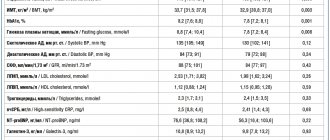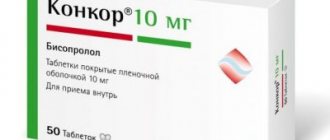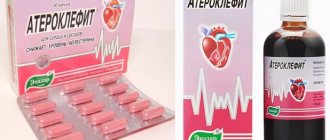Dietary supplement Cardioleptin
Cardioleptin is used to normalize metabolism in the heart muscle, heart rate, helps lower blood pressure, has a calming effect, and lowers blood cholesterol levels.
Ingredients: extracts of propolis, rose hips, hawthorn fruits, peppermint leaves, marigold flowers. Excipients: lactose, glucose.
Area of application: as a dietary supplement - an additional source of flavonoids and phenolic compounds.
Action:
Cardioleptin contains a large list of substances that affect the cardiovascular system:
- Cardioleptin flavonoids (vitexin-2-O-rhamnoside, hesperidin, hyperoside, isorhamnetin, isorhamnetin 3-O-glucoside, catechin, quercetin, neohesperidoside, patuletin, procyanidin B(2), rhamnosylrutinoside, rutin, epicatechin) have antioxidant, capillary-strengthening, anti-inflammatory properties. , diuretic effect. Of particular importance are quercetin and hyperoside, which also have a pronounced anti-ischemic effect, and hesperidin, which regulates venous tone.
- Phenolic compounds and a complex of phenolcarboxylic acids have a pronounced antioxidant, anti-inflammatory, anti-ischemic, hepatoprotective, and hypoglycemic effect.
- An important component of the biological activity of the drug are terpenoids, the main source of which is mint leaves. The most important of them are menthol and menthone, which have a reflex coronary and analgesic effect.
- Other compounds worth mentioning are acetylcholine, contained in hawthorn fruits. Acetylcholine slows down the heart rate, improves the blood supply to the myocardium, and helps lower blood pressure.
The effectiveness of the dietary supplement "Cardioleptin" has been confirmed by clinical studies conducted in patients with hypertension and coronary heart disease at the State Research Center for Clinical and Experimental Medicine of the Siberian Branch of the Russian Academy of Medical Sciences. Cardioleptin improved the results of drug therapy in the form of faster normalization of blood pressure and improved well-being of patients. Patients receiving Cardioleptin more often had positive ECG changes. The study also confirmed the high antioxidant activity of the drug, assessed by increasing the resistance of blood lipoproteins to peroxidation.
Based on the research conducted, it is recommended by the Scientific Center for Clinical and Experimental Medicine of the Siberian Branch of the Russian Academy of Medical Sciences for complex therapy
- hypertension;
- atherosclerosis;
- coronary heart disease.
Contraindications: individual intolerance to the components, pregnancy, breastfeeding.
Instructions for use of dietary supplement Cardioleptin
Adults: 1-2 tablets 3-4 times a day with meals. Duration of treatment is 2–4 weeks. Taking into account the chronobiological characteristics of the cardiovascular system, the most effective use of the dietary supplement "Cardioleptin" is for "larks" at 12-00, 16-00, 20-00 hours, for "owls" and "pigeons" at 14-00, 18-00 and at 22-00. Combination with the dietary supplement Leptoprotect enhances the effect.
RELEASE FORM: Tablets 50 pcs.
Cardioleptin - early help for cardiovascular diseases
Dushkin Mikhail Ivanovich, Doctor of Medical Sciences, Head. Laboratory of Immunology of Atherosclerosis IKI SB RAMS
It is well known that cardiovascular diseases rank first in mortality in Russia and highly developed countries. First of all, these are myocardial infarctions - the consequences of coronary heart disease. The widespread prevalence of coronary heart disease among the population began in the second half of the twentieth century; in the nineteenth century it was still considered a rarity. Compared to the nineteenth century, by the end of the twentieth the incidence rate had increased 60 times. Despite preventive measures, new operational and therapeutic approaches, by 2010 the incidence rate is predicted to increase by another 20%. We can say that cardiovascular diseases are becoming epidemic. What is the cause of this terrible disease?
In 95% of heart disease, the cause of cardiovascular disease is the formation of plaque in the arteries, called atherosclerosis . Atherosclerosis begins with the deposition of cholesterol in blood vessels and the development of inflammation in the vessel. As a result of plaque formation, it begins to protrude into the lumen of the vessel. If this is a vessel that supplies the heart muscle, then its narrowing causes an insufficient flow of oxygen, “starvation” of the heart area. A person does not feel the development of an atherosclerotic plaque in a vessel. Atherosclerosis acts like a time bomb. Chest pain occurs as a consequence of atherosclerotic vasoconstriction during “starvation” of heart cells.
Often the disease creeps up without symptoms or with sensations that are not paid attention to. The outcome of the disease is dramatic. A plaque protruding into a vessel can suddenly rupture, and a blood clot immediately forms at the site of the rupture, completely plugging the vessel. Myocardial infarction develops, which often ends in death. Russian statistics on the development of heart attacks are ominous - heart attacks have become “younger”, and cases of their development at 35-45 years of age have become more frequent. It was found that in men aged 35 years, 40% of the vessels are affected by atherosclerosis. Every year, the consequences of atherosclerosis claim about a million lives of Russians, of whom a good half are men of working age, as they say, “in full force.”
Is it possible to get rid of atherosclerosis and protect yourself from a heart attack?
It is possible if, from a certain age (from 30-35 years or more) and in the early stages of the disease, the causes that cause it are eliminated. Everyone knows that high blood cholesterol is bad. According to the World Health Organization, reducing its level by 10% reduces the risk of heart attack by 20%. But not everyone is interested in their cholesterol level, much less thinks about how to reduce it. Until the thunder strikes, the man will not cross himself.
In fact, every day we are faced with stressful situations, which often leads to increased blood pressure and increased heart rate. But stress and hypertension significantly increase the risk of cardiovascular complications. The so-called “oxidative stress” also plays a leading role in the development of the disease, i.e. the formation of oxidized lipids and cholesterol when attacked by aggressive oxygen radicals.
High levels of antioxidants were found in propolis extracts and rose hips. Hawthorn fruits have the ability to lower blood pressure, and the substances contained in mint and calendula reduce blood cholesterol levels, normalize cardiac activity, and have an anti-stress effect. Based on propolis and these medicinal plants, the dietary supplement “Cardioleptin” was created, which has a versatile effect and eliminates several causes of cardiovascular diseases at once. In fact, “Cardioleptin” can be classified as parapharmaceuticals – medicinal substances of plant origin that, unlike medications, do not have side effects.
Who needs to take Cardioleptin and how to take it?
Before answering this question, let's look at what therapists and cardiologists recommend for patients with coronary heart disease. Basically, these are drugs that reduce cholesterol synthesis, which are called statins . Whatever statin you choose, it should be taken for life. Stopping statins can lead to a sharp increase in cholesterol levels. This is just one of the side effects of chemically synthesized statins.
Cardioleptin does not have such side effects, but is milder. Therefore, for prevention, young people can take Cardioleptin 2 tablets 3 times a day for 2-3 months a year . It's another matter if you are over 40 years old and feel that your heart is starting to play tricks. In this case, the duration of taking Cardioleptin increases to at least six months. Well, if a heart attack does occur, for the rehabilitation of post-infarction conditions it is best to combine drug therapy and constant use of Cardioleptin.
Of course, you should not expect a sharp drop in blood cholesterol levels by 30-40% from Cardioleptin, as happens when taking high doses of statins. But as clinical studies have shown, the use of Cardioleptin in combination with medications for 3-4 weeks leads to a rapid restoration of heart rate, blood pressure, and normalization of lipid metabolism. In addition, regardless of medication use, Cardioleptin has a calming effect and, most importantly, effectively protects blood vessels from aggression by oxygen radicals. It is not without reason that cardiologists in Novosibirsk have included Cardioleptin in the arsenal of recommended drugs and are receiving good practical results. Therefore, I appeal to you, dear consumers, do not wait for thunder to strike and you or your loved ones to have a heart attack or stroke. Recommend Cardioleptin, especially to men over 35 years of age, because they often have no time to take care of their health, and they suffer from atherosclerosis much more often than women. Of course, this also applies to women, especially with hormonal changes that occur with menopause and diabetes.
“Cardioleptin” will save you from cardiovascular diseases, which means it will make your life much longer and more active!
Cardioleptin
Ingredients: Extracts of mint, hawthorn fruit, rose hips, calendula flowers, propolis. Indications: Cardioleptin is used for diseases of the cardiovascular system, including hypertension, atherosclerosis, coronary heart disease, dystrophic and sclerotic changes in the myocardium, and increased cholesterol levels in the blood.
Diseases of the cardiovascular system are among the most common throughout the world. In the pathogenesis of both hypertensive and coronary heart disease, an important role is played by overstrain of higher nervous activity under the influence of stress factors, lipid metabolism disorders, changes in blood viscosity, metabolic disorders, the development of “oxidative stress”, etc.
In the development of atherosclerosis, which manifests itself as coronary heart disease, damage to the vessels of the brain and large arteries of the extremities, free radical mechanisms play an extremely important role. They are involved in damage to the inner lining of the arteries and blood lipid peroxidation, resulting in the accumulation of oxidized lipids in the vessel wall causing the formation of atherosclerotic plaques. Cardioleptin, by suppressing lipid oxidation, prevents the development of atherosclerosis, normalizes metabolism in the heart muscle, helps lower blood pressure, normalize heart rate, and has a calming effect.
The plants that make up Cardioleptin have a diverse effect due to the content of coumarin, salicylic, malic, ascorbic acids, essential oils, tocopherol, carotene, flavonoids, alkaloids, minerals, organic acids, tannins. In folk medicine, these plants in the form of teas and infusions were used to lower blood pressure, improve blood circulation in the coronary vessels, lower cholesterol levels, and for sedative purposes.
The use of the parapharmaceutical Cardioleptin in combination with drug therapy in patients with hypertension and coronary heart disease is aimed at lowering blood pressure, correcting lipid metabolism and metabolic disorders, improving blood flow in the coronary arteries, normalizing heart rate and calming effects, as well as the manifestation of antioxidant and vascular strengthening effects .
Contraindications: Individual intolerance to components, pregnancy, breastfeeding. Not recommended for use in childhood. Before use, you should consult your doctor.
Recommendations for use: Adults, 1 tablet 3-4 times a day with meals. Duration of treatment is 2–4 weeks. Release form : 50 tablets weighing 550 mg per package.
Storage conditions: Store at a temperature not exceeding +20°C in a place protected from light. Shelf life: 2 years.
Not a medicine.
CARDIOLEPTIN (Cardiovascular leptin)
Ingredients: extracts of mint, hawthorn fruit, rose hips, calendula flowers, propolis.
Cardioleptin is used for diseases of the cardiovascular system, including hypertension, atherosclerosis, coronary heart disease, dystrophic and sclerotic changes in the myocardium, and increased cholesterol levels in the blood.
Diseases of the cardiovascular system are among the most common throughout the world. In the pathogenesis of both hypertensive and coronary heart disease, an important role is played by overstrain of higher nervous activity under the influence of stress factors, lipid metabolism disorders, changes in blood viscosity, metabolic disorders, the development of “oxidative stress”, etc.
In the development of atherosclerosis, which manifests itself as coronary heart disease, damage to the vessels of the brain and large arteries of the extremities, free radical mechanisms play an extremely important role. They are involved in damage to the inner lining of the arteries and blood lipid peroxidation, resulting in the accumulation of oxidized lipids in the vessel wall causing the formation of atherosclerotic plaques. Cardioleptin, by suppressing lipid oxidation, prevents the development of atherosclerosis, normalizes metabolism in the heart muscle, helps lower blood pressure, normalize heart rate, and has a calming effect.
The plants that make up Cardioleptin have a diverse effect due to the content of coumarin, salicylic, malic, ascorbic acids, essential oils, tocopherol, carotene, flavonoids, alkaloids, minerals, organic acids, tannins. In folk medicine, these plants in the form of teas and infusions were used to lower blood pressure, improve blood circulation in the coronary vessels, lower cholesterol levels, and for sedative purposes.
The use of the parapharmaceutical Cardioleptin in combination with drug therapy in patients with hypertension and coronary heart disease is aimed at lowering blood pressure, correcting lipid metabolism and metabolic disorders, improving blood flow in the coronary arteries, normalizing heart rate and calming effects, as well as the manifestation of antioxidant and vascular strengthening effects .
We conducted clinical studies on the basis of the State Research Center of Clinical and Experimental Medicine of the Siberian Branch of the Russian Academy of Medical Sciences, the purpose of which was to study the effect of Cardioleptin on the dynamics of clinical symptoms, blood pressure levels and lipid metabolism in patients with diseases of the cardiovascular system (hypertension, coronary heart disease) .
Determination of lipid metabolism indicators, the state of the blood coagulation system, and electrocardiography were carried out over time - upon admission to the hospital and after 14 days. All patients had their blood pressure levels monitored daily.
Patients in the study and control groups received drug therapy, which was prescribed according to indications.
Upon admission to the hospital, patients complained of increased blood pressure (BP), interruptions in heart function, shortness of breath when walking, and swelling in the legs. In 10 people in the study group, upon admission to the clinic, blood pressure was registered at 160-170/100-95 mmHg. The pulse rate ranged from 80 to 62 per minute.
In the control group, in 12 patients, an increase in blood pressure was also recorded at high levels of 165-175/100-105 mmHg, the pulse rate ranged from 86 to 70 per minute.
The ECG showed various changes of a sclerotic nature in all patients of the study group.
In the control group, similar changes were recorded in 9 people.
During treatment, all patients noted an improvement in their well-being. The dynamics of clinical symptoms are presented in Fig. 8.
In the study group, 1 patient continued to have moderate shortness of breath, and in the control group, 3 patients continued to be bothered by interruptions in heart function, and in 2 patients shortness of breath persisted.
In all patients, systolic and diastolic blood pressure normalized.
The ECG showed positive dynamics in most patients (Fig. 9).
A biochemical blood test in the experimental group revealed a significant decrease in fibrinogen levels, while lipid metabolism indicators did not change.
An increase in the resistance of low-density lipoproteins to peroxidation was found when taking Cardioleptin (Table 3).
Table 3. Changes in lipid peroxidation products in serum LDL (Nmol malonaldehyde/mg LDL protein) (M ± m)
| Before taking Cardioleptin | After taking Cardioleptin | ||
| 0 min incubation | 30 min incubation | 0 min incubation | 30 min incubation |
| 5,55 ± 0,57 | 21,4 ± 1,4 | 3,06 ± 0,44* | 16,03 ± 1,1* |
| * — p < 0.05 | |||
Normal: 16-17 nmol MDA/mg LDL protein
Cardioleptin is well tolerated, no side effects were noted.
Conclusions:
- Used in the complex treatment of patients with hypertension and coronary heart disease, Cardioleptin has a positive effect on the dynamics of clinical symptoms.
- Taking Cardioleptin in combination with drug therapy normalizes blood pressure.
- Cardioleptin has high antioxidant activity, as evidenced by an increase in the resistance of blood LDL to peroxidation
Improvement in the well-being of patients, normalization of blood pressure and the absence of side effects allows us to recommend taking Cardioleptin in the complex treatment of patients with diseases of the cardiovascular system.






